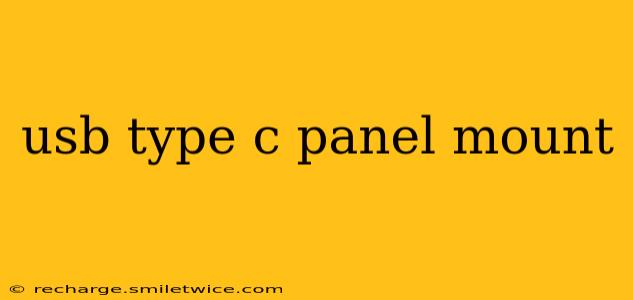Choosing the right USB Type-C panel mount can be crucial for various applications, from industrial settings to consumer electronics. This guide delves into the intricacies of these connectors, helping you understand the options available and how to select the perfect fit for your needs. We’ll cover everything from different connector types and considerations to frequently asked questions.
What are USB Type-C Panel Mounts?
USB Type-C panel mounts are connectors designed to be integrated directly into panels or surfaces. Unlike standard USB Type-C cables, these are permanently affixed, providing a robust and aesthetically pleasing connection point for devices. They offer a range of functionalities, including data transfer, power delivery, and video output, all through a single, reversible connector. This makes them extremely versatile and increasingly popular across various industries.
Types of USB Type-C Panel Mounts
Several types of USB Type-C panel mounts cater to different needs and applications. These variations focus primarily on:
-
Durability and Environmental Protection: Some panel mounts are designed to withstand harsh environments, featuring robust housings and higher IP ratings for dust and water resistance. Industrial applications often require this level of protection.
-
Data Transfer Speeds: Panel mounts support various USB data transfer speeds, including USB 2.0, 3.0, 3.1, and 3.2. Choosing the right speed depends entirely on the application's requirements. Higher speeds are essential for applications requiring fast data transfer, such as video streaming or large file transfers.
-
Power Delivery Capabilities: Many USB Type-C panel mounts support Power Delivery (PD), enabling higher power output for charging laptops, tablets, and other power-hungry devices. The power delivery capabilities should align with the power requirements of the connected devices.
What are the Key Features to Consider When Choosing a USB Type-C Panel Mount?
Selecting the appropriate USB Type-C panel mount requires careful consideration of several factors:
-
Durability: The connector's robustness is crucial, especially in industrial or high-traffic areas. Look for mounts with robust construction and high IP ratings (Ingress Protection) to protect against dust, water, and other environmental factors.
-
Mounting Style: Consider the mounting style that best suits your application. Options range from simple screw-in mounts to more complex solutions that require specialized tools.
-
Connector Type: Choose the correct USB Type-C connector based on the desired data transfer speed and power delivery capabilities. Ensure compatibility with your devices.
-
Compatibility: Verify the panel mount's compatibility with the devices you plan to connect. This includes ensuring compatibility with the USB version, Power Delivery capabilities, and any other relevant specifications.
-
Application: The intended use heavily influences the selection. A panel mount for a rugged industrial machine will differ significantly from one used in a sleek consumer product.
How do I Install a USB Type-C Panel Mount?
The installation process varies depending on the specific panel mount. Consult the manufacturer's instructions for detailed guidance. Generally, it involves cutting a precisely sized hole in the panel, securing the mount in place using screws or other fasteners, and connecting the necessary cables and wiring. Proper installation is critical to ensure functionality and longevity.
What is the difference between a USB Type-C panel mount and a standard USB Type-C connector?
The primary difference lies in the mounting style. A panel mount is designed for permanent integration into a panel or surface, while a standard USB Type-C connector is typically found on cables and devices that can be easily connected and disconnected. Panel mounts offer a more integrated and often more robust solution for fixed installations.
What are the benefits of using a USB Type-C panel mount?
The benefits include:
- Improved Aesthetics: Provides a clean and professional look.
- Enhanced Durability: Often more durable than standard connectors.
- Easy Access: Offers convenient and readily available connectivity.
- Versatility: Supports various data transfer speeds and power delivery capabilities.
This guide provides a solid foundation for understanding and selecting USB Type-C panel mounts. Remember to always carefully review specifications and consult with manufacturers for specific requirements. The correct choice will ensure optimal functionality, durability, and a seamless user experience.
